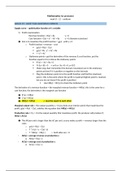Samenvatting
SUMMARY MATHEMATICS FOR PREMASTER - week 7-11 - endterm material
- Vak
- Mathematics
- Instelling
- Tilburg University (UVT)
Detailed summary of all lecture material including examples and exercises, focused on the material discussed in weeks 7 - 11. All material for the endterm of mathematics for premaster
[Meer zien]




